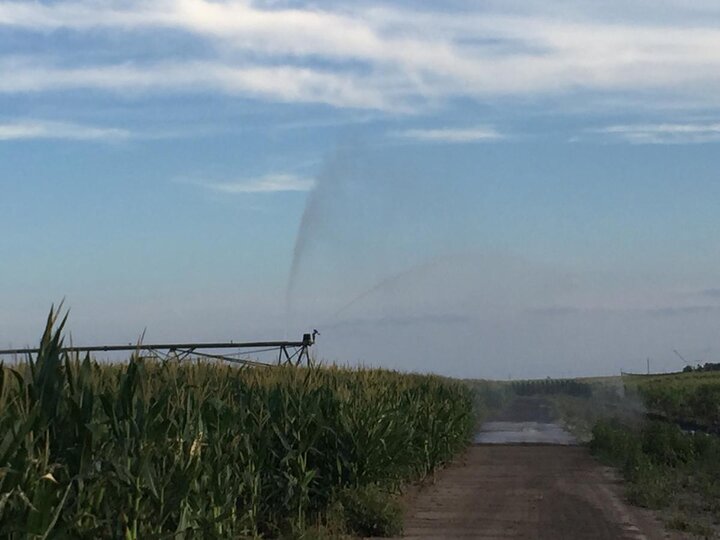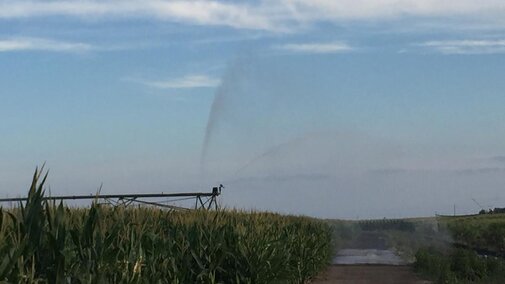By this time of year, everyone is ready to be done irrigating; however, now is the perfect time to evaluate your irrigation equipment and the crop it irrigated to see what needs to be fixed or improved before the start of next season. Many pivot service providers have excellent off-season service specials; however, some problems can only be diagnosed while the system is operating and before the crop is harvested. During the last irrigations, take a close look at how the equipment is working as well as how uniformly the crop was watered.
Before you shut down your systems for the season, take time to check them out and make a list of what needs to be fixed or improved to increase irrigation performance for the next season.
Sprinkler Packages, Leaks, and Pumps
Operating pressure is the key item to measure for center pivots. If the water pressure is not right, the system cannot work correctly. In addition, measuring the system flow will help with diagnostics.
In order to check pressure, you'll need a working pressure gauge and an understanding of operating pressure design for your system. The best place to find the designed operating pressure and flow is to reference the sprinkler chart, which came with the sprinkler package when it was purchased new with the pivot or as a replacement package. It is often placed in the pivot panel. The sprinkler chart is different for almost every pivot because every sprinkler package is custom designed for that pivot’s flow rate and length, thus the specific chart for the pivot being evaluated needs to be used. The sprinkler chart contains a lot of information, including
- designed operating pressure and flow rate,
- details about position of all the sprinklers,
- length of each span, and
- overall length of the pivot.

If you cannot find the sprinkler chart, request one from the dealer who sold the sprinklers.
Measure the pressure at the pivot point and near the end of the pivot. Check the pressure at the end of the pivot when the last tower is in the highest point in the field. For the regulators to work correctly the pressure in the pivot mainline needs to be at least 5 psi over the rated pressure of the regulator.
Assuming the pressure was correct when the sprinkler package was new, if pressure now is too high, check for plugged nozzles or restrictions in the pipeline.
If the pressure is too low, it indicates too much water is exiting the pivot or there is a problem with the pump output. A flow meter is a helpful tool in this situation because it will tell you if you have more or less water flowing through the system than the design calls for. Sometimes producers assume the flow meter is bad if the flow is different than what the system is designed to provide. If this is a concern, the flow meter can be removed and tested by the manufacturer to make sure it is operating correctly.
Irrigation pumps in wells can have a diminished flow for several reasons. Some of them are:
- An internal combustion engine powers the pump and the speed has slowed down.
- The water pumping level in the well has dropped, requiring extra energy to lift the water and thereby reducing flow.
- The pump is damaged or worn out.
- There is a restriction in the pipeline or a plugged well screen.
Low pressure with high flow rates indicates that more water is leaving the pivot system than was designed to. The excess flow can be coming from leaks, bad pressure regulators, or worn or missing sprinklers. Often these problems can be seen by just looking at the water pattern coming out of the pivot with the sun reflecting on it in the morning or in the evening. In a properly functioning system the water distribution should appear even with a gradual increase in water volume from the center point to the outer end. Worn-out pressure regulators and sprinklers can be hard to see, however, so consider replacing them every 8 to 10 years.
When looking at the sprinkler pattern, also note broken or missing sprinklers and damaged rubber boots where the spans connect. If a sprinkler needs to be replaced, take the sprinkler to the irrigation dealer or look it up in the sprinkler chart so you get the correct regulator and sprinkler with correct nozzle size for that portion of the pivot.
Another good way to evaluate the sprinkler package is to look for non-uniform circular patterns in the crop. Often they become visible in summer aerial images or if bad enough, from the combine cab at harvest. Do not rely on the combine yield monitor to pick up sprinkler problems because those areas are usually fairly narrow and the width of the combine head will often collect grain from both poorly and well-watered areas.
Pivot Tracks
Center-pivot track management can be a major problem in some instances. Note affected areas. Wheel options and other techniques have been developed to solve most of these problems. Deep tracks most of the way around the field can indicate over irrigation and/or small frequent applications. Often, just using a better irrigation scheduling system can greatly reduce the track depth. If the problem is just in one part of the field, it may require changing something on the pivot (wheels, sprinklers, etc.) or adding pivot bridges or crushed rock to problem areas. For more information see the Central Plains Irrigation Conference paper: Center Pivot Track Management Options.
Leaky Gates and Gaskets
Furrow irrigation is a reasonably efficient irrigation system if it is well managed and maintained. However, leaky gates and gaskets can waste a lot of water and cause yield loss in the rows with the leaks. Evaluate each pipeline, marking problems on the pipe or piles of pipe so the problems can be corrected this winter. Many producers add shut-off valves to keep as much of the pipeline dry as possible to minimize water loss.

